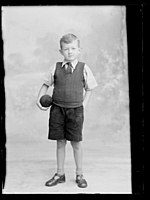T-bar sandal: Difference between revisions
m Bot: galleries syntax |
dab |
||
| Line 17: | Line 17: | ||
File:Telyn Gothic newydd i Christine Lee, 9 oed, o Ros-y-bol (8517453105).jpg|A girl harpist wearing twin-strap T-bar sandals in Wales, 1960. |
File:Telyn Gothic newydd i Christine Lee, 9 oed, o Ros-y-bol (8517453105).jpg|A girl harpist wearing twin-strap T-bar sandals in Wales, 1960. |
||
File:NW, MW & ADW in 1964.jpg|Studio photograph of boys wearing T-bar sandals in [[Colombo]], Sri Lanka, 1964. |
File:NW, MW & ADW in 1964.jpg|Studio photograph of boys wearing T-bar sandals in [[Colombo]], Sri Lanka, 1964. |
||
File:Brownie and Girl Guide Uniforms Canada circa 1975 (8202402537).jpg|A [[Girl Guide]] and a [[Brownies|Brownie]] wearing T-bar sandals in Canada, about 1975. |
File:Brownie and Girl Guide Uniforms Canada circa 1975 (8202402537).jpg|A [[Girl Guide]] and a [[Brownies (Scouting)|Brownie]] wearing T-bar sandals in Canada, about 1975. |
||
File:Hunting-MacGregor.jpg|A 4 year-old boy wearing a kilt and T-bar sandals in Scotland, 1987. |
File:Hunting-MacGregor.jpg|A 4 year-old boy wearing a kilt and T-bar sandals in Scotland, 1987. |
||
</gallery></center> |
</gallery></center> |
||
Revision as of 16:42, 6 November 2018
This article needs additional citations for verification. (May 2009) |

A T-bar sandal or T-bar shoe (also known in the United Kingdom as "school sandal" or "closed-toe sandal") is a closed, low-cut shoe with two or more straps forming one or more T shapes (one or more straps across the instep passing through a perpendicular, central strap that extends from the vamp).
Classic T-bars for children are typically made of blue or brown leather, have two thin straps forming a single T shape and fastened with a buckle, a broad and rounded toebox pierced with a pattern of holes, a low heel, and a crêpe rubber outsole stitched-down to the upper. Among boys, T-bars are traditionally worn with socks, short trousers, and a shirt.
History
First seen in Europe and America in the early 1900s, T-bars became very common among children in the 1950s,[1] particularly among boys where they supplanted pre-war Mary Janes. T-bar wearing declined after the 1960s nonetheless, following the cultural and clothing revolution that swept the West.
Today, T-bars for children, particularly the more classic styles, are often considered semi-formal shoes, appropriate for school (some primary schools in the United Kingdom require that pupils wear them with their uniform[2]). They may also be viewed as formal shoes for boys, suitable for religious ceremonies, weddings, visits, and birthday parties for example. More modern styles are also worn in casual settings, however: playgrounds, shopping centres, etc. Although less popular than in the past, T-bars remain a timeless classic of children's fashion and, for many people, a symbol of childhood.
Gallery
-
Studio photograph of a 7 year-old boy wearing T-bar sandals in Strabane, Northern Ireland, 1915.
-
A girl harpist wearing twin-strap T-bar sandals in Wales, 1960.
-
Studio photograph of boys wearing T-bar sandals in Colombo, Sri Lanka, 1964.
-
A Girl Guide and a Brownie wearing T-bar sandals in Canada, about 1975.
-
A 4 year-old boy wearing a kilt and T-bar sandals in Scotland, 1987.
References
- ^ Rose, Clare (1989). Children's Clothes: Since 1750. London: B. T. Batsford Limited. p. 149. ISBN 0-7134-5741-4. OCLC 19812913. Retrieved 10 June 2013.
- ^ "Closed-toe Sandals". Historical Boys' Clothing. 8 November 2006. p. 149. Retrieved 10 June 2013.






